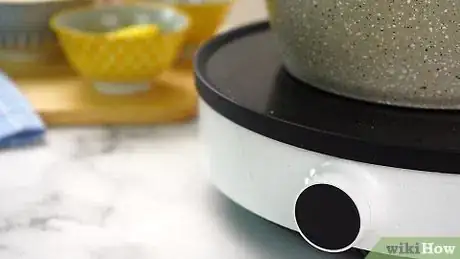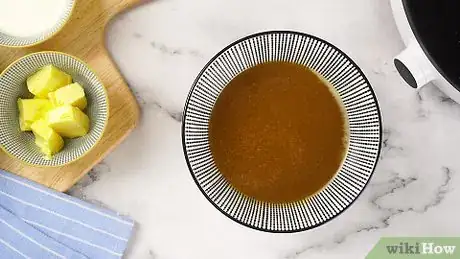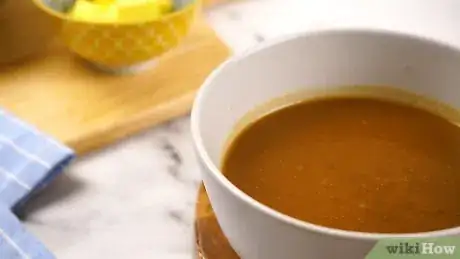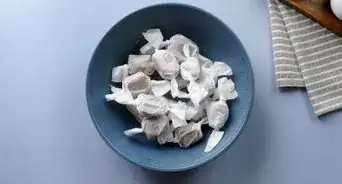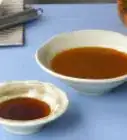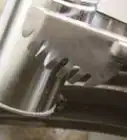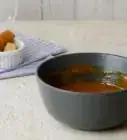This article was co-authored by Jessica Banh. Jessica Banh is a Pastry Chef and the Owner of Fancy Flavors in San Jose, California. With over 12 years of technical experience, Jessica has expertise in a wide variety of pastry techniques and has a focus on macarons. Her work has been featured in The SF Chronicle, The Mercury News, and Good Morning America. She received her training from The Professional Culinary Institute.
This article has been viewed 321,332 times.
Have you ever gone for a tasty bowl of vanilla ice cream with caramel sauce, only to discover that your teenager ate the last of the caramel sauce...on a hamburger? Kids will eat anything, but take heart: making your own caramel sauce from scratch is a lot easier—and a lot tastier than you might think. Even better, it takes practically no time at all. All you need is some sugar, butter, and cream to make your own caramel sauce at home!
Ingredients
- 1 1/4 cup (300 ml) sugar
- 4 oz. (112 g) butter
- 3/4 cup (175 ml) cream, room-temperature or warmed
- 1/4 cup (60 ml) water (wet method only)
Makes approximately 2.5 cups:
- 100g unsalted butter
- 1 1/2 cups brown sugar
- 1 cup cream
- 1 teaspoon vanilla extract
Steps
Dry Caramel Preparation
-
1Gather your ingredients. The cream and the butter should be measured out, sitting next to the pan and ready to be added. Making caramel sauce is a fast process; if you are wasting time looking for ingredients when your sugar is burning, you're not going to end up with caramel sauce you'll want to eat.
-
2Combine the butter and sugar. On medium-low heat, add the butter and sugar to a heavy-bottomed, 2- or 3-quart saucepan.
- Do not stir the sugar and butter as it dissolves. If you need to, swirl the mixture gently to combine the ingredients, but not much. You want the caramelization to start from the bottom and let it work its way up.
Advertisement -
3Heat the mixture. Leave the sugar and butter mixture on medium-low for 5 to 8 minutes. Keep an eye on the caramel sauce. Swirl the mixture if necessary to prevent burning, but do not stir.
- If you find that you end up burning some of the sugar before the rest of it is melted, the next time you attempt your caramel sauce, add a half cup of water to the sugar at the beginning of the process. This is called a "wet" caramel sauce. (See below.)
- The wet caramel sauce recipe will help the sugar to cook more evenly, although it will take longer to cook—the water will need to evaporate before the sugar will begin to caramelize.
-
4Check the color. After 5 to 8 minutes, the mixture should turn a light brown. You should still see small bunches of sugar crystals which have not yet crystallized.
- If sugar crystals start forming on the sides of the pan, use a brush to wipe them back down into the mixture.
-
5Keep the sauce on medium-low. Continue cooking until the remaining crystals caramelize and bubbles start to form. The color should be deep auburn. This could take two minutes, or it could take another five.
- This is the time to really guard against burning. You don't want to leave the sauce unattended at this point.
- If you're worried about the sauce burning, you can turn the heat down to low. It's better to take a little longer cooking than to hurry the process and burn the caramel.
- Keep resisting the urge to stir. Swirl if you need to, but don't stir yet!
-
6Remove the pan from the burner. After all the sugar crystals have caramelized, take the pot off the burner, and mix in the cream a little at a time. Now is the time when you can finally use a whisk to stir.
- Mix in the cream in small batches and stir vigorously. The mixture will foam up and grow in volume.
- As you mix in the rest of the cream, the sauce will turn a darker color. The sauce will keep on bubbling as the cream gets incorporated into the sugar and butter.
-
7Strain the mixture. Pour the caramel into a heat-resistant bowl or jar, through a strainer. Any uncaramelized crystals left will not make it into the final mixture.
-
8Let the sauce sit to cool to room temperature. Except, of course, the caramel that you put on your ice cream!
- Store in the refrigerator for up to 2 weeks. Warm it up before serving.
Wet Caramel Preparation
-
1Gather your ingredients. The cream and the butter should be measured out, sitting next to the pan and ready to be added. Making caramel sauce is a fast process; if you are wasting time looking for ingredients when your sugar is burning, you're not going to end up with caramel sauce you'll want to eat.
-
2In a 2- to 3-quart saucepan, combine sugar and water. Turn heat on high and wait for mixture to start boiling, stirring constantly.[1]
- When the mixture comes to a boil, turn the heat down to medium-low, and stop stirring completely to prevent crystallization.
- Allow mixture to boil undisturbed until it turns a deep amber. It should look like the color of dark beer.
- You can also use a thermometer to determine when it is time to stop cooking. The mixture should reach 350 to 375 °F (177 to 191 °C).
-
3Remove the sauce from the heat. Mix in the butter into the sauce, then slowly and carefully pour the cream into the caramel, stirring regularly. Careful: the sauce will bubble up furiously![2]
- Scrape the thick parts that settle on the bottom. If lumps develop, put the pan on the heat again, and stir until the lumps dissolve.
-
4Get it to a nice, viscous consistency. The mixture should be uniform after cooling slightly and stirring.
- Strain into a heat-resistant bowl or jar and wait until caramel sauce is cool enough to serve.
Cream Based Caramel Sauce
-
1Place the butter into a heavy-based saucepan. Heat gently (low heat).[3]
-
2Add the sugar and cream. Stir constantly until the sugar dissolves.[4]
-
3Simmer for 8 to 10 minutes over low heat. Stir constantly; this prevents the sugar from crystallizing.
-
4Remove once the sauce has just thickened.
-
5Add the vanilla extract. Stir through.
-
6Serve. This sauce can be used warm or cold.
- If you need to store, this sauce will keep for up to 7 days if covered and refrigerated.
Community Q&A
Did you know you can get answers researched by wikiHow Staff?
Unlock staff-researched answers by supporting wikiHow
-
QuestionHow do I fix burnt caramel sauce?
 wikiHow Staff EditorThis answer was written by one of our trained team of researchers who validated it for accuracy and comprehensiveness.
wikiHow Staff EditorThis answer was written by one of our trained team of researchers who validated it for accuracy and comprehensiveness.
Staff Answer wikiHow Staff EditorStaff Answer
wikiHow Staff EditorStaff Answer -
QuestionWhat do I do if caramel sauce hardens?
 wikiHow Staff EditorThis answer was written by one of our trained team of researchers who validated it for accuracy and comprehensiveness.
wikiHow Staff EditorThis answer was written by one of our trained team of researchers who validated it for accuracy and comprehensiveness.
Staff Answer wikiHow Staff EditorStaff AnswerPlace the caramel sauce back on low heat and stir gently as it warms enough to melt again. Adding a little cream or water once it has warmed will make it even softer and keep it that way. For full instructions on fixing a hardened caramel sauce, see the wikiHow How to Thin Caramel.
wikiHow Staff EditorStaff AnswerPlace the caramel sauce back on low heat and stir gently as it warms enough to melt again. Adding a little cream or water once it has warmed will make it even softer and keep it that way. For full instructions on fixing a hardened caramel sauce, see the wikiHow How to Thin Caramel. -
QuestionWill caramel sauce get stuck in my teeth?
 wikiHow Staff EditorThis answer was written by one of our trained team of researchers who validated it for accuracy and comprehensiveness.
wikiHow Staff EditorThis answer was written by one of our trained team of researchers who validated it for accuracy and comprehensiveness.
Staff Answer wikiHow Staff EditorStaff AnswerNormally caramel sauce shouldn't stick in between your teeth; usually it is caramel toffees that get stuck. However, if your caramel sauce is thick or whatever it is covering gets stuck as well (such as a little piece of pudding), then you can just use floss or a toothpick to ease it out, then brush your teeth to make them clean again.
wikiHow Staff EditorStaff AnswerNormally caramel sauce shouldn't stick in between your teeth; usually it is caramel toffees that get stuck. However, if your caramel sauce is thick or whatever it is covering gets stuck as well (such as a little piece of pudding), then you can just use floss or a toothpick to ease it out, then brush your teeth to make them clean again.
Warnings
- Be extra careful whilst you are cooking the sugar: once the sugar has melted, it has a much higher temperature than boiling water—and it's very sticky.⧼thumbs_response⧽
- Use pot holders when handling the jar filled with hot caramel sauce, as it will burn you.⧼thumbs_response⧽
- Be sure to pour the hot caramel sauce into a thick Pyrex glass or jar. Do not use a normal glass jar or one that has not been made for temperature changes, as the high temperature of the caramel sauce would likely crack it.⧼thumbs_response⧽
References
About This Article
To make caramel sauce, first add 1 cup (200 g) of granulated sugar and 1/3 cup (80 mL) of water to a saucepan. Heat the sugar and water over medium heat and stir until the sugar dissolves. Add 6 tablespoons (90 g) of butter to the pan. Stir the ingredients until the butter melts into the sugar, then remove the pan from the burner. Whisk the mixture to break up any clumps then place the pan back on the stovetop and slowly add 1/2 cup (120 mL) of heavy cream. Add 1 teaspoon (6 g) of salt, and mix everything together over high heat until it comes to a boil. Let the mixture cook for 1 more minute before turning the heat off. Pour the caramel sauce into a glass container and let it thicken and cool. It will store well in the fridge for up to 1 month. If you want to learn how to make a cream-based caramel sauce, keep reading the article!

